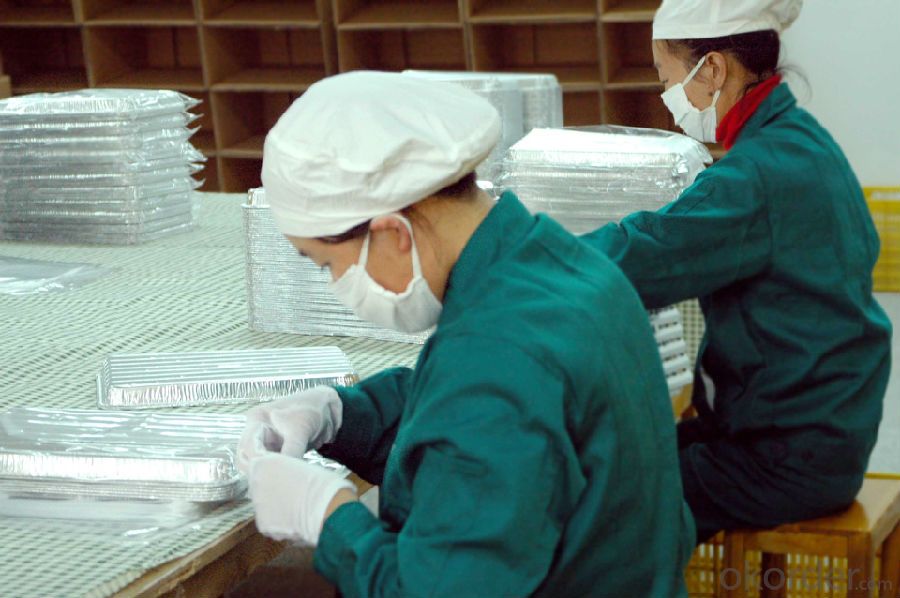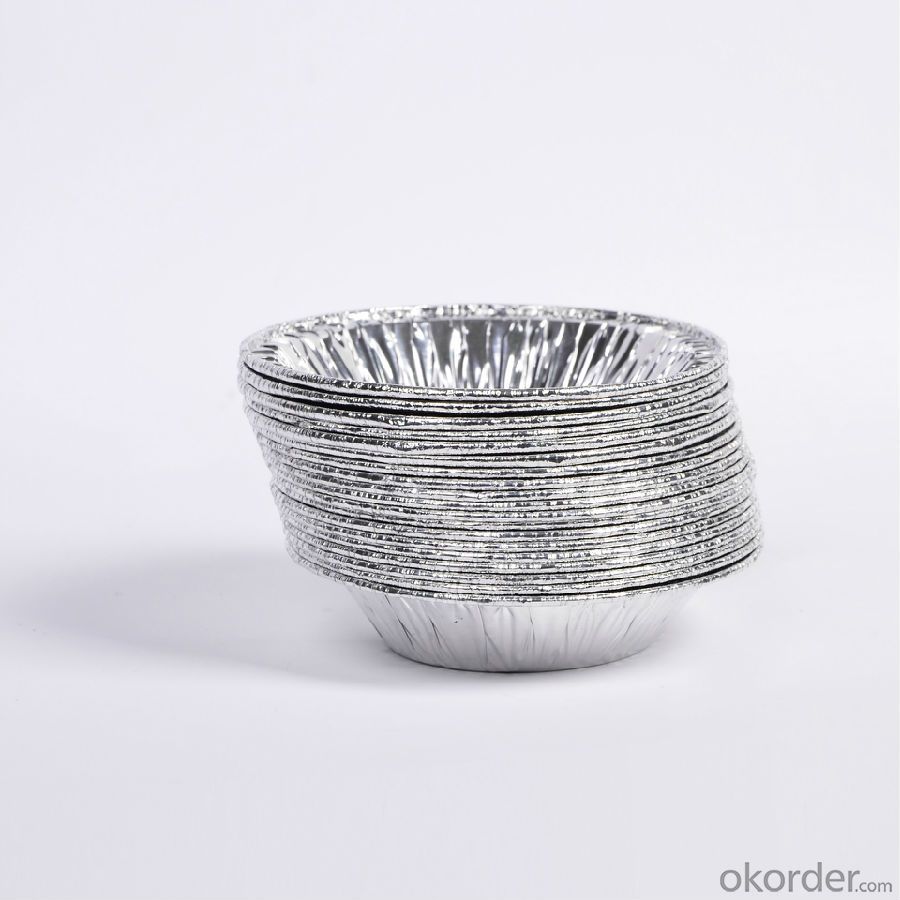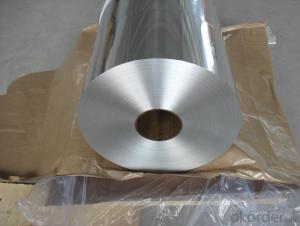Aluminium Foil for Food Container with Best Quality
- Loading Port:
- Shanghai
- Payment Terms:
- TT OR LC
- Min Order Qty:
- 5 m.t.
- Supply Capability:
- 2000 m.t./month
OKorder Service Pledge
OKorder Financial Service
You Might Also Like
Item specifice
Structure of Aluminium Foil for Food Container with Best Quality Description:
We have more than 10 years experiences on manufacturing kinds of aluminum profiles, such as Aluminum Window & Door profiles, Aluminum tile trim profiles, Aluminum profiles for LED light, Round/Square General profiles, Aluminum heat sink, Aluminum heating insulation profiles, Curtain wall Aluminum profiles, and others Industry profiles.
Our products have exported to all over the world, and we also have a large of market share in Algeria, Angola, Philippine, Guinea, Ghana, South Africa, Nepal, Nigeria, Tanzania, Iraq etc.
Main Features of the Aluminium Foil for Food Container with Best Quality:
1, Strong R&G: help customers finalize the design, strong tool design ability, excellent, pressing and surface treatment technology;
2, Strong quality management: ISO&SGS SYSTEM;
3, 24 hours on-line communication, professional, patient, flexible;
4, High capacity of manufacturing and wide range of products;
5, We can provide secondary manufacturing.
6, High corrosion resistance, high weather resistance and good wear resistance.
7, Alternative surface treatment: Colorful ANODIZE, POWDER COATING, ELECTROPHORESIS & WOODEN GRAIN. Plentiful colors upon your needs.
8, Excellent material for smooth and subtle edges, elegant appearance.
9, Strong coated adhesion which is suitable for construction and industrial material.
Images of the Aluminium Foil for Food Container with Best Quality:



Aluminium Foil for Food Container with Best Quality Specification:
Material | Alloy Aluminum 6063,6061,6005 or customer nominated |
Temper | T3, T4, T5, T6 |
Surface | Anodize, electrophoresis, powder coating, PVDF coating, wood grain painting, matted, etc. |
Colour | Any colour based on Standard Germany RAL Mark |
Length | Coating 6.5 meters, Anodizing 6.5 meters, Mill finish 5 meters |
Press Machine | 500-4000 tons all together 64 press lines. |
Fabrication | 1. Windows and doors; 2. Drilling; 3. Bending; 4. Cutting; 5. etc. |
Certificate | ISO 9001 |
Moulding | 1. Using our moulds, no fee; |
2. Using customer drawing, opening mould, usually about 10~50 tons then the moulding can be refunded. | |
3. Mould cost is negotiable base on the order quantity | |
Capability | Annual output 100,000 tons |
FAQ:
1.Q: What about leadtime ?
A: Normally the leadtime is 60days after we receive the deposit and confirm the details. All the press machines we use is the best quality in China Yangli brand. The press machine leadtime from Yangli is 50days, the best leadtime we can give is 60days.
2.Q: What's the lead time for moulds?
A: Normally the mould leadtime is 45 days after we confirm all the details with customer. Our professional mechanical enginners from Austria will design the mould according to the samples from customer, or by the specifications offered by customers.
3.Q:What kinds of mould you can make? and what is your strong point for the moulds?
A: we can make wrinkle wall mould and smooth wall mould both. For wrinkle wall mould we can make, 79" pan, fish pan, bbq pan. For smooth wall mould we can make muffin cup, and cake cup, tar cup,etc. We can also make 2 or 3 portion conatiner moulds as long as you offer us sample or specifications. Our strong points are all our moulds are WEDMLS cut, which makes the mould more accurate and precise. Important materials likestainless steel parts we make in Austria. We also recut after heat treatment, which most of makers do not take this process.
- Q:What is the difference between the type 4040c and 4040d of aluminum profile?
- No drawings, really difficult to say, each manufacturer of profiles on the naming method is not the same.
- Q:Can aluminum profiles be used in automotive applications?
- Yes, aluminum profiles can be used in automotive applications. Aluminum profiles are lightweight, strong, and corrosion-resistant, making them suitable for various automotive components such as body panels, chassis parts, and engine components. Their use helps reduce the overall weight of the vehicle, improving fuel efficiency and performance.
- Q:How can I control the hardness of 6063 aluminum profile at 6-9 degrees?
- Classification: extension material, non heat treatment alloy and heat treatment alloy1.1 non heat treated alloys: pure aluminum - 1000 series, Al Mn alloy - 3000 series, Al Si alloy - 4000 series, Al Mg alloy - 5000 Series1.2 heat treatment of Al Cu Mg alloy alloy: 2000, aluminum magnesium silicon alloy - 6000 series aluminium zinc magnesium alloy - 7000.Two, alloy number: China's current general is the American Aluminum Association "Aluminium Association" numberExamples are as follows: 1070-H14 (pure aluminum)2017-T4 (heat treatment alloy)3004-H32 (non heat treated alloy)2.1 first digit: indicates the main addition of alloying elements1: pure aluminum2: the main alloy element added copper3: the main alloying elements are manganese or manganese and magnesium4: the main alloy element is added silicon5: the main alloying element is magnesium6: mainly add alloy elements for silicon and magnesium7: the main alloying elements are zinc and magnesium8: a new alloy that does not belong to the above alloy series2.2, second digits: an alloy that indicates the addition of alloying elements or impurities in the original alloy0: table alloy1: table original alloy by the first amendment2: table original alloy after second modifications2.3, third, and four digits:Pure aluminum: represents the original alloyAlloy: the designation of individual alloys"- >: the back of Hn or Tn indicates the condition of work hardening or the symbol of heat treatment state-Hn: indicating the symbol for non heat treated alloys-Tn: a symbol for heat treatment alloysHeat treatment of 2 aluminium and aluminium alloyA chain symbol: if the alloy element is added, it is not enough to meet the requirements, but still needs cold processing, quenching and agingTreatment and soft burning to obtain the required strength and performanceAs a result of quenching and tempering, the result of quenching and tempering is chain
- Q:How do aluminum profiles compare to other types of materials?
- Aluminum profiles have several advantages over other types of materials. Firstly, aluminum is lightweight, making it easier to handle and transport. It is also highly resistant to corrosion, making it ideal for outdoor or high-moisture environments. Additionally, aluminum profiles offer excellent strength-to-weight ratio, providing structural stability without unnecessary weight. Moreover, aluminum is a highly versatile material that can be easily shaped and customized to meet specific design requirements. Lastly, aluminum is sustainable and recyclable, making it an environmentally friendly choice. Overall, aluminum profiles offer numerous benefits in terms of durability, versatility, and sustainability compared to other materials.
- Q:Can aluminum profiles be used for access control systems?
- Access control systems can utilize aluminum profiles, which are a versatile and durable material commonly used in construction and various industries. Aluminum offers an excellent strength-to-weight ratio and corrosion resistance, making it ideal for doors, frames, and enclosures. These profiles can easily accommodate locks, hinges, control panels, and readers. The lightweight nature of aluminum allows for easy installation and maintenance. Additionally, different coatings can be applied to enhance appearance and protect against harsh conditions. Customization is also possible, as aluminum profiles can be cut, drilled, and assembled to fit specific design requirements. Overall, aluminum profiles are a reliable and practical choice for securing access points.
- Q:5002 and 6063 aluminum profiles difference
- 6063 is generally used in architectural profiles.The main alloy elements of 5002 aluminum alloy are magnesium and silicon, and form Mg2Si phase. If it contains a certain amount of manganese and chromium, it can neutralize the bad action of iron.
- Q:What are the bending capabilities of aluminum profiles?
- Aluminum profiles have excellent bending capabilities due to their inherent properties. Aluminum is a highly malleable metal, which means it can easily be formed into various shapes without fracturing or breaking. This makes it ideal for applications that require complex bending or curving. The bending capabilities of aluminum profiles largely depend on the alloy used and the specific shape or design being bent. Certain aluminum alloys, such as 6061 or 6063, are commonly used for extruded profiles and offer excellent bending properties. These alloys have a good balance of strength and formability, making them well-suited for bending applications. The bending process for aluminum profiles typically involves using specialized machinery, such as a bending machine or a press brake. The profile is carefully positioned and clamped, and then pressure is applied to bend it to the desired shape. The process can be done in multiple passes to achieve tight or gradual bends. Aluminum profiles can be bent to various angles, including sharp bends or gentle curves, depending on the application requirements. The bending radius, or the minimum radius that the profile can be bent without causing deformation, depends on the profile's thickness, alloy, and temper. Thinner profiles generally have smaller bending radii compared to thicker ones. It is important to note that excessive bending or bending beyond the material's capabilities can lead to cracking or permanent deformation. Therefore, it is crucial to consider the specific bending requirements and consult with experts or manufacturers to ensure proper bending techniques and limitations are followed. Overall, aluminum profiles offer excellent bending capabilities, allowing for the creation of intricate and custom shapes. Their versatility and formability make them a popular choice in industries such as construction, automotive, aerospace, and furniture manufacturing.
- Q:Is the aluminum profile insulated and broken hot?
- Yes, the name is not the same, the professional name is "broken hot aluminum alloy", most people used to call "broken bridge aluminum"
- Q:What are the different surface engraving or etching techniques for aluminum profiles?
- Aluminum profiles can be engraved or etched using various techniques, each with its own advantages and outcomes. Some commonly employed methods are as follows: 1. Chemical Etching: By selectively removing the top layer of the aluminum profile using chemicals, this technique enables precise and intricate designs to be etched onto the surface, making it ideal for decorative purposes. 2. Laser Engraving: Employing a high-powered laser beam to vaporize the aluminum surface, this approach yields a permanent etching. It allows for exceptional precision, making it suitable for detailed designs and logos. 3. Mechanical Engraving: This technique involves physically engraving the aluminum profile's surface using rotary cutters or diamond-tipped tools. It is frequently used in industrial applications, such as marking product codes or serial numbers. 4. Electrochemical Etching: By utilizing an electric current and an electrolyte solution, this method etches the aluminum surface. It is often used to create durable and legible markings, such as product labels or identification codes. 5. Sandblasting: This process entails directing abrasive particles at high speed onto the aluminum surface, removing its top layer. The result is a textured or frosted appearance, often employed for decorative purposes or to achieve a matte finish. 6. Acid Etching: Acid etching involves the use of an acid solution to selectively remove the top layer of the aluminum surface. It is commonly employed to create a matte or satin finish, as well as patterns or textures on the profile. These techniques present a wide array of options for aluminum profiles, allowing for customization, branding, or functional purposes. The selection of a specific technique depends on factors such as the desired design, level of detail, durability requirements, and intended application of the aluminum profile.
- Q:Can aluminum profiles be used in corrosive environments?
- Before making a decision, it is important to take certain factors into consideration when using aluminum profiles in corrosive environments. Aluminum naturally resists corrosion due to the formation of a protective oxide layer on its surface. This layer acts as a barrier, preventing further corrosion. However, in highly corrosive environments such as areas with high humidity, exposure to saltwater, or acidic conditions, the protective oxide layer may degrade over time. To enhance the resistance of aluminum profiles in corrosive environments, several measures can be taken. One option is to select an aluminum alloy with higher corrosion resistance, such as marine-grade or corrosion-resistant alloys that contain a higher percentage of alloying elements like copper or zinc. Furthermore, surface treatments like anodizing or powder coating can further enhance the corrosion resistance of aluminum profiles. Anodizing involves the creation of a thicker and more durable oxide layer on the aluminum surface, while powder coating provides an additional protective layer that acts as a barrier against corrosive agents. Regular maintenance and cleaning are also crucial for preserving the corrosion resistance of aluminum profiles in corrosive environments. This includes the removal of any accumulated dirt or debris that may contain corrosive substances. In conclusion, while aluminum profiles can be used in corrosive environments, it is vital to choose the appropriate alloy, consider surface treatments, and perform regular maintenance to ensure their long-term performance and durability.
1. Manufacturer Overview |
|
|---|---|
| Location | |
| Year Established | |
| Annual Output Value | |
| Main Markets | |
| Company Certifications | |
2. Manufacturer Certificates |
|
|---|---|
| a) Certification Name | |
| Range | |
| Reference | |
| Validity Period | |
3. Manufacturer Capability |
|
|---|---|
| a)Trade Capacity | |
| Nearest Port | |
| Export Percentage | |
| No.of Employees in Trade Department | |
| Language Spoken: | |
| b)Factory Information | |
| Factory Size: | |
| No. of Production Lines | |
| Contract Manufacturing | |
| Product Price Range | |
Send your message to us
Aluminium Foil for Food Container with Best Quality
- Loading Port:
- Shanghai
- Payment Terms:
- TT OR LC
- Min Order Qty:
- 5 m.t.
- Supply Capability:
- 2000 m.t./month
OKorder Service Pledge
OKorder Financial Service
Similar products
New products
Hot products
Related keywords































